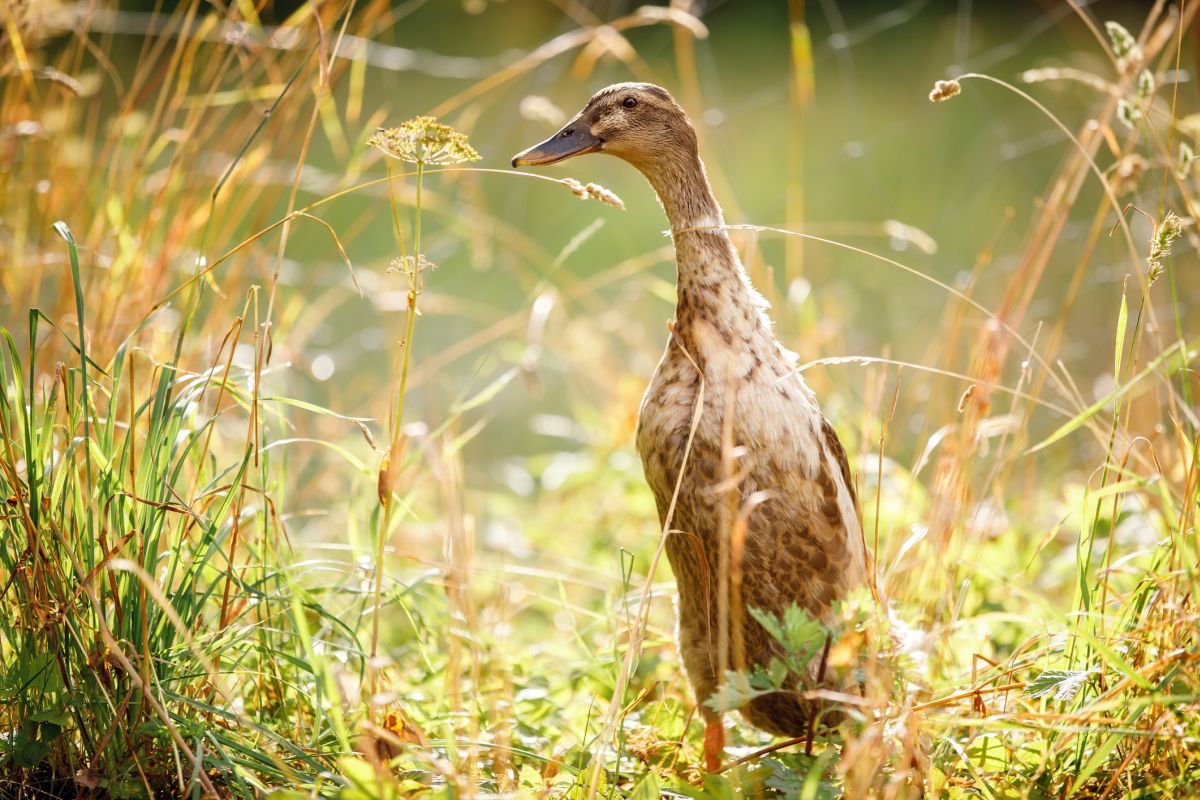If you’re interested in raising ducks, Indian Runner ducks might be the best breed for you. They have many color varieties, they have a unique stature, and they lay a lot of eggs each year.
These ducks require a decent amount of time with their humans, but they’re usually friendly and unlikely to get sick. So, if you’re looking for a fun, unique duck breed, these might be the feathered friends for you.
Indian Runner Duck Overview
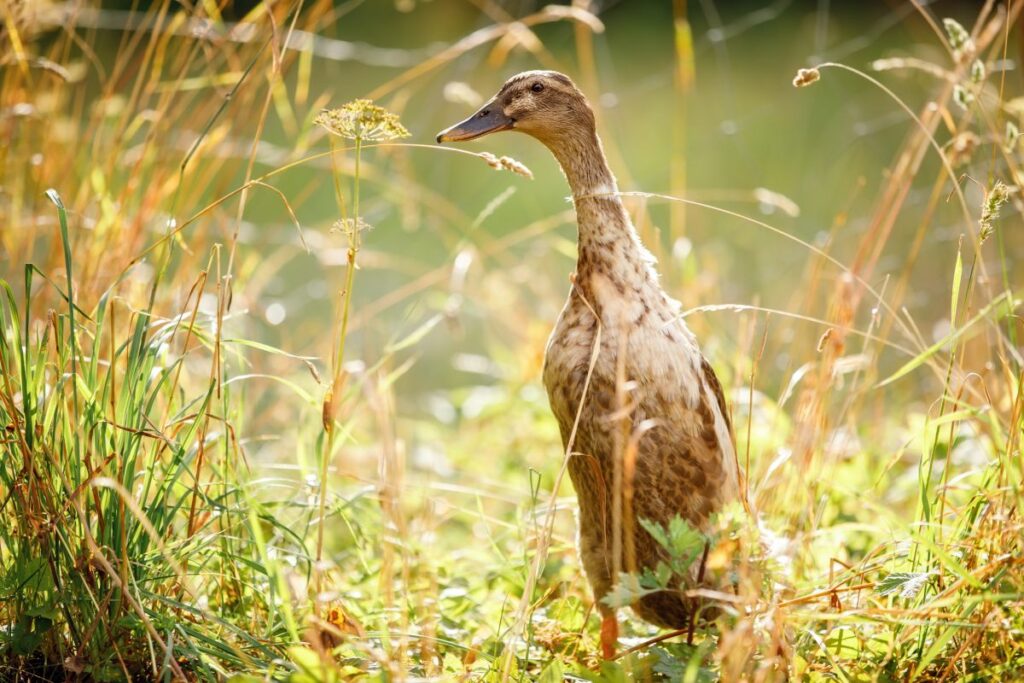
Here’s an overview of this type of duck’s traits to help you decide if you want to raise any.
| Lifespan | 8 to 12 years |
| Weight | 3.5 to 5 pounds |
| Appearance | A tall posture with a variety of feather colors |
| Egg Color | Pastel green |
| Egg Production | 5 to 6 per week |
| Good for Beginners? | Yes |
| Minimum Coop Size | 4 to 6 square feet per duck |
| Price | $5 to $10 per duckling |
Indian Runner Duck History
Indian Runner ducks are believed to be some of the oldest domesticated ducks. Ancient hieroglyphics in Javan temples have depictions of the breed from over 2,000 years ago. The ducks pictured are suspected to be Indian Runners because of their tall statures.
These ducks likely originated from Indonesia in the 1800s. They were great at eating pests in fields, so keepers let them roam free throughout the day.
Since they have better egg laying capabilities than most ducks, they were often crossbred with other ducks to create “designer breeds” that looked nice and laid lots of eggs. They were bred with other breeds so often that purebred Indian Runners almost disappeared at one point.
Today, Indian Runners are common domesticated ducks again. They’re often kept in large flocks for pest control and egg laying.
Appearance
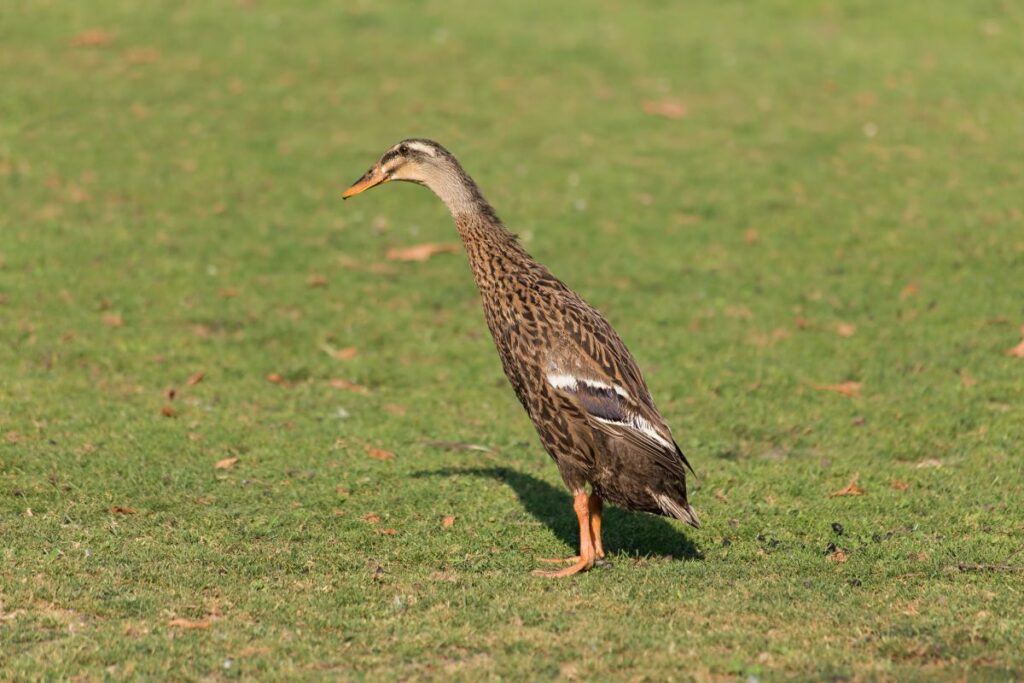
The most notable trait about these ducks is that they stand upright like a penguin. Their backs are long and straight, and they hold their heads high in the air. Their shape has earned them the nickname “bowling pin duck.”
Unlike other ducks, these birds can’t waddle because their legs are further back. They can run fast, but their wings are too small to fly.
Size and Weight
Indians Runners are light ducks, but males are slightly heavier. Hens weigh between 3 and 4.5 pounds while drakes weigh 3.5 to 5 pounds.
Hens stand 24 to 28 inches tall, and drakes are 26 to 32 inches.
Indian Runner Duck Colors
Most Indian Runner ducks are a shade of brown, but there are many color varieties you could end up with.
Here are the common colors of this breed:
- Fawn
- White
- Black
- Blue
- Gray
- Buff
- Chocolate
- Green
While fawn and white are the most common feather colors, blue Indian Runner ducks are one of the most desirable varieties.
No matter how dark the feathers on these birds are, their skin is always pink underneath.
Baby Indian Runner ducks look similar to other ducklings. They have fuzzy feathers that are usually a mix of yellow and brown.
Males vs. Females
Besides the males being bigger than the females, there are not many significant differences between the two sexes. Males usually have curly feathers on their tails, but females do not.
You can also differentiate the two based on the sounds they make. Hens make a traditional quacking sound while drakes make a softer, raspier sound.
Temperament
Indian Runner ducks are known as friendly, docile birds, but they can be skittish around strangers.
Once they get to know someone, these ducks will be less fearful and easier to train. They require more human interactions than other breeds, otherwise they may live their whole lives stressed and scared.
Since they require a more hands-on approach to their care, they’re not suitable for keepers with busy schedules. You’ll need to dedicate time to gaining their trust and keeping them entertained.
Noise Levels
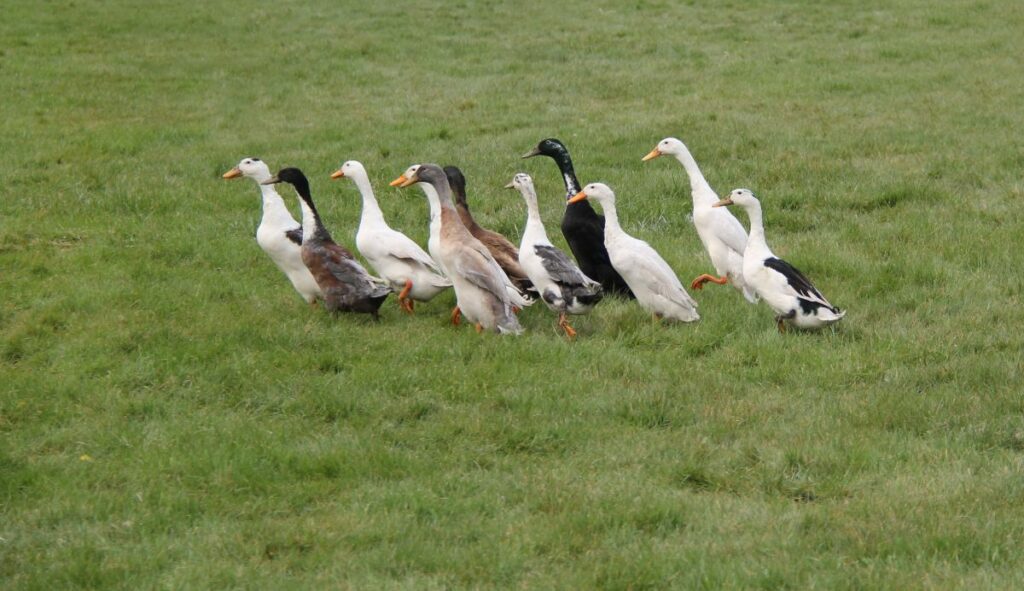
These ducks are only moderately noisy. The hens will quietly quack amongst themselves throughout the day, but it’s unlikely to cause a disturbance.
The drakes are even quieter since they make a low, raspy sound instead of quacking.
Broodiness
It’s very rare for Indian Runner hens to go broody. If you want to breed more ducks, you’ll need to scoop up the eggs and put them in an incubator right away and raise the eggs yourself to help them survive.
Even if a hen acts broody around the eggs, she will not be a good mother once they hatch. So, if there’s a rare instance where the female sits on the eggs, you’ll need to move the chicks to a safer area as soon as they hatch.
Do They Get Along with Other Animals?
Indian Runners can live with other duck species and chickens, but you’ll want to choose the breeds carefully. Pick birds that are a similar size and temperament to the ducks to avoid any fights.
Also, if you’re not planning to breed your birds, keep males out of the enclosure.
Indian Runner Ducks Care Requirements
Indian Runners are unique ducks that have special care requirements. So, here are some tips for how to care for them.
Feeding
Ducks rarely overeat, so it’s safe to free feed them. Adult ducks need a layer feed that has between 15% and 19% protein. Ducklings will need a feed with extra protein to support their growing bodies.
These ducks are great at foraging. They can find nutrients by searching the ground nearby, making them great at pest control. The food they get from foraging should only be in addition to their feed, not in place of.
Like chickens, ducks love to free range. Free ranging gives them more space to explore and lowers their stress levels. If you feel comfortable with it, give your Indian Runner ducks some free range time. As long as they have all their basic needs near the coop, they won’t run away.
Enclosure
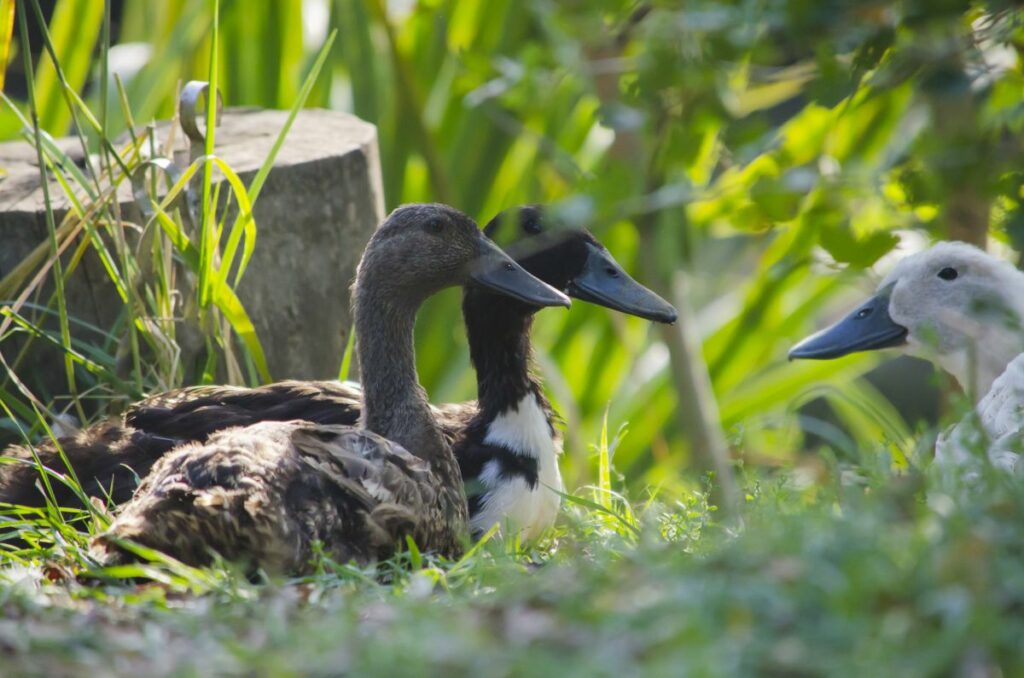
Indian Runner ducks do best when they live in groups of the same species, but they’ll still need plenty of space to spread out and stretch their legs. In the coop, each duck should have between 4 and 6 square feet. More space is always better if possible.
Outside the coop, there should be at least 10 to 25 square feet of space per bird. They love to run around and forage, so the more room they have to roam, the happier they’ll be. When foraging, they prefer to explore as far from their coop as possible.
While chicken coops need roosts, a duck enclosure doesn’t. Indian Runners don’t sleep on roosts, but instead, they huddle together on the floor of the coop. These birds also prefer to lay their eggs on the ground, so nesting boxes aren’t necessary. Most ducks will find a corner with bedding to lay their eggs.
Since ducks spend more time on the ground than chickens, make sure you’re changing their bedding regularly. Clean bedding will keep them comfortable and reduce the risk of catching diseases.
Temperature
Indian Runner ducks do well in all temperatures, even extreme hot and cold. Their egg production may reduce during cold months, but it’s unlikely to stop completely.
Even though these ducks are hardy, you’ll still need to follow necessary precautions in extreme temperatures. No matter the weather, make sure they have access to clean water. The coop should also be well-ventilated.
In the summer, the ducks should have lots of access to shade. In the winter, you might want to consider a coop heater, depending on where you live.
Health Concerns
These ducks aren’t prone to many health concerns. They’re hardy birds that rarely get sick, and they do well in both hot and cold temperatures.
So, the only main health concern you might have to deal with is parasites. These ducks can get worms by interacting with contaminated food, water, or soil. Luckily, veterinarians can offer de-worming procedures to nurse your bird back to health.
Some herbs, such as oregano, honey, thyme, and garlic, can help prevent worms and other health concerns, but they might not be as effective as medication prescribed by a professional.
The best way to avoid issues is to keep the coop as clean as possible. Make sure the food and water is always fresh and remove any harmful objects from the enclosure.
If you’re ever concerned about your duck’s health, consult a veterinarian for the best advice. It’s a good idea to familiarize yourself with vets that care for birds before something goes wrong.
Egg Production
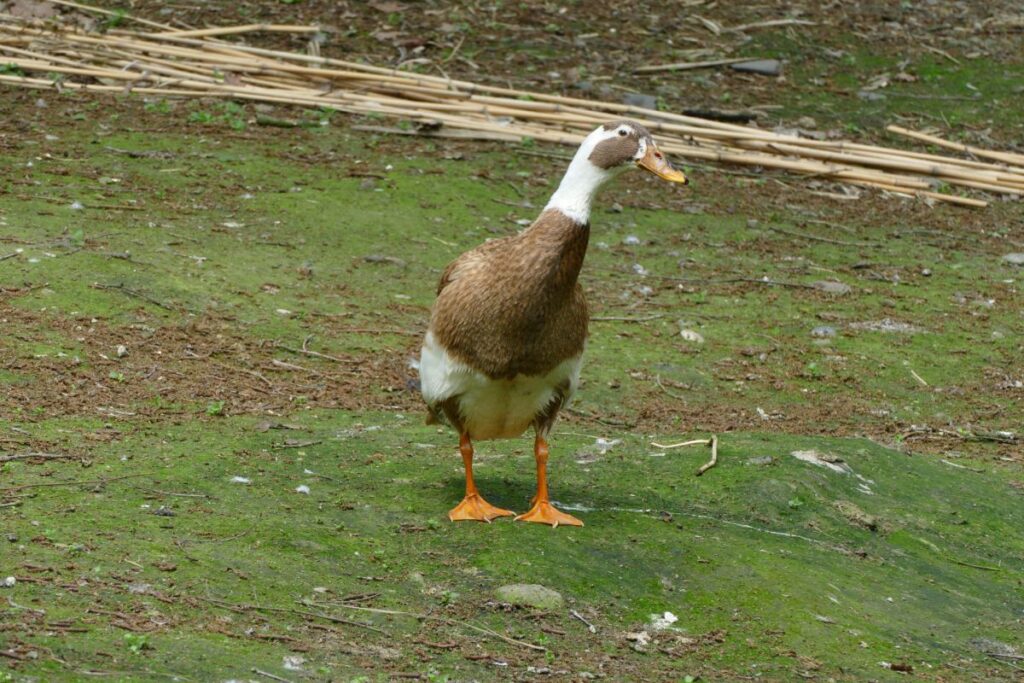
Indian Runner ducks have excellent egg production, and they even produce more eggs than most chickens. They lay 5 to 6 eggs per week, which ends up being 300 to 350 eggs per year.
Indian Runner duck eggs are large and a beautiful pastel green color. The hens start laying eggs as early as 4 months old, but they won’t get into a routine until they’re 6 to 7 months old.
Many people prefer duck eggs over chicken eggs because they have a richer flavor that’s better for baking. Plus, they’re larger than chicken eggs, so you won’t need as many for a recipe.
If you raise these ducks, you can try some recipes that work better with duck eggs.
Frequently Asked Questions
Before you bring some Indian Runner ducks home, make sure you’ve done all your research. Here are some questions that new duck keepers commonly ask.
Indian Runner ducks usually live between 8 and 12 years, which is higher than the average duck. The quality of care you provide will cause this range to increase or decrease.
No, these ducks cannot fly at all. Their unusual body shapes and small wings make them unable to lift themselves off the ground.
Indian Runner ducks are usually 24 to 32 inches tall. They’re taller than other duck breeds because of their upright posture.
Look for duck breeders near you that specialize in this breed. A good breeder should be knowledgeable about the specific needs and traits of Indian Runners. Don’t be afraid to ask lots of question to ensure that you’re buying healthy ducks.
Are Indian Runner Ducks Right for You?
Indian Runner ducks are a great duck breed for beginners, as long as you’re willing to take some time to earn their trust. Their unique posture and excellent egg production is what sets them apart from other ducks. They even outshine most chickens when it comes to laying eggs, so they’re a great breed to consider.
